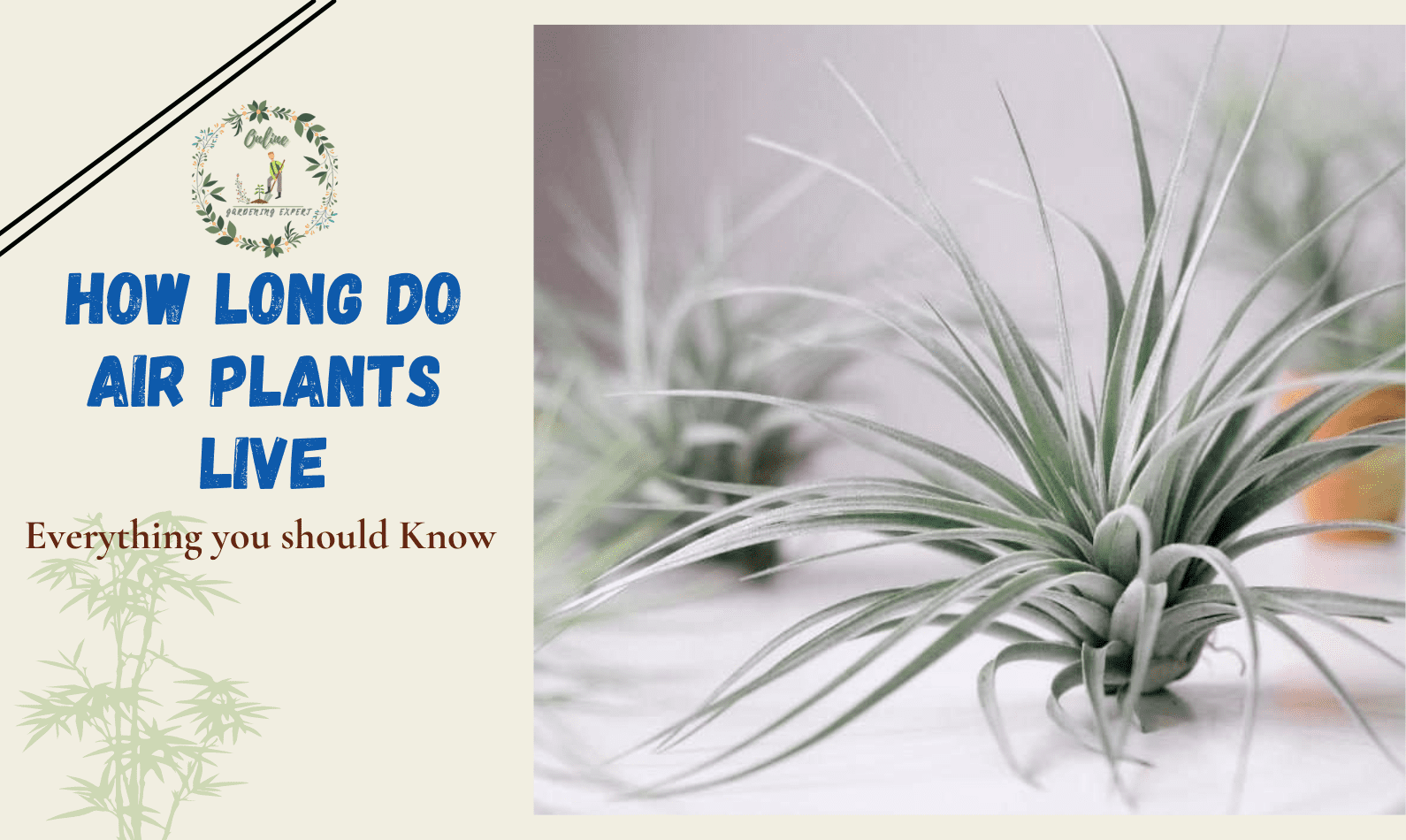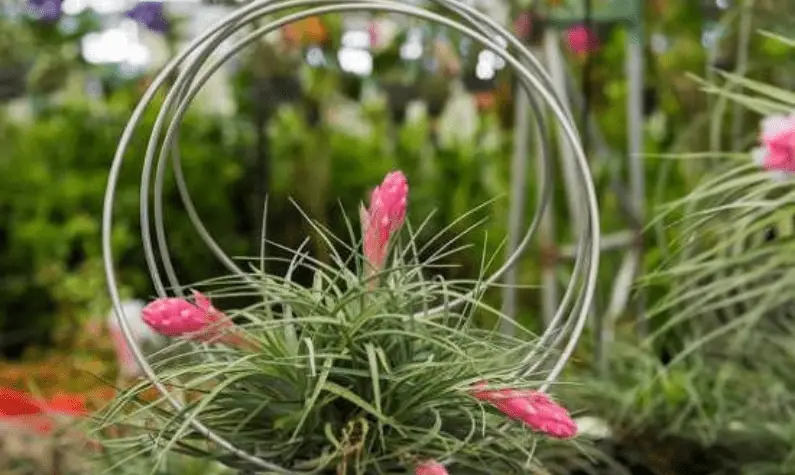How Long Do Air Plants Live: Air plants have been established for thousands of years and are still in use today. If new plants are regularly propagated from “pups,” which are broken-off leaves from the mother plant, the life cycle of an individual air plant can be prolonged to years or even generations. Because they are quite simple to produce and care for, they are particularly popular among beginning gardeners.
Of course, they may be found in the natural world, but they are also becoming increasingly common in people’s homes as their popularity increases. Air plants are similar to every other plant that we grow, except that most kids thrive best when not planted in soil.
If you’re just getting started with plants, air plants are a terrific place to start. It is possible to grow them in a small flower pot, and they are a low-maintenance option for bringing life into your home without the dirt, labor, and lack of space that comes with a plant that demands a larger flower pot.
Contents
- Why Is It So Special About Air Plants?
- How Are Air Plants Different From Other Plants?
- Caring For Air Plants
- Tips To Enhance The Life Expectancy Of Air Plants
- How Long Do Air Plants Live: The Lifespan Of An Air Plant
- Conclusion
- What are the signs of a dying air plant?
- How to know if the air plant is dead?
- What are the most common reasons for air plants to die?
Why Is It So Special About Air Plants?
Epiphytic (meaning that they may grow on various things or hang in the air without a pot), air plants, also known as Tillandsia, are long-lived plants that can live for many years. They don’t even require water regularly because they take it from the air through the leaves of their plants. This is why bathrooms and kitchens are excellent locations for displaying them.
Some individuals like them as an alternative to flowers because they are less expensive. These fascinating little plants are found in various habitats around the world; some are prized by Native Americans and have a long history of interaction with people.
Currently, air plants can be found in most garden centers as well as on e-commerce plant websites, where a large range of air plants is available for purchase online.
Even though air plants can be propagated from seeds, this approach is rarely suggested because it is a far longer and more complicated procedure than propagating plants from pups, which are offshoots of a mother plant.
How Are Air Plants Different From Other Plants?
One aspect in which they differ is in the manner in which they can be cultivated. Contrary to popular belief, they do not require soil, and a broken-off leaf can regenerate into a completely new plant. When it comes to air plants, watering is a very different story.
Air plants are a better alternative for people who want to be “greener” and friendlier to the environment by using less water in their homes.
They can also survive for far longer periods of time without the requirement for soil or water. The only thing you’ll need to do is put them somewhere where they’ll get plenty of indirect natural light from the sun. Make sure you don’t leave them alone for an extended period.
Caring For Air Plants
Air plants are generally low-maintenance and thrive in bright, indirect light, while most types require indirect light for the best results. They also require little water and may survive for long periods as long as they have roots and leaves. It is possible to keep an air plant in the same location for several years at a time. Certain types of air plants can thrive in soil depending on the variety.
There is little to fear when it comes to accidentally killing your air plant because tillandsia plants are extremely resilient and do not die easily. As long as you keep a few things in mind, which may vary depending on the variety of your plant, you should have little reason to be concerned about accidentally killing your air plant.
The majority of air plants should not be put in soil because this can result in root rot in the plant. Because they require more water, varieties with a greener hue will be the most likely candidates for soil planting because they require less water. These cultivars are also more vulnerable to direct sunlight than other variants.
Lighter-colored types require less water and will benefit the most from growing in the air or on an object instead of darker-colored varieties. These cultivars are more resistant to heat and drought than other kinds.
Find out what your specific air plant type needs in order to provide the best care possible. Maintain a distance of at least a few feet between your air plant and a window in order to ensure that it receives a suitable quantity of natural, indirect sunlight.
If the limbs of your air plants are completely dry, they will not live. Make careful to water them at the root level on a regular basis. Make sure you don’t over-or under-water your plants. This entails soaking your plant for around 20 minutes in a bowl of water once a week and spraying it frequently, especially during hot weather.
When your plant is kept outside, it will benefit from the nutrients it may take from the surrounding air. However, when it comes to overexposure to sunshine, these plants are quite sensitive. An air plant that receives too many hours of direct sunshine, especially if the sun is exceptionally intense, will experience a great deal of stress, which could result in death.
Tips To Enhance The Life Expectancy Of Air Plants
There are many various ways to take care of an air plant, and you can experiment with whichever method works best for your schedule. However, there are certain basic guidelines to follow, which are as follows:
- Decide where you want to keep your air plant. If your plant is in a place with a lot of humidity, such as the bathroom, the amount of water you need to give it will vary. If the room becomes too hot, you’ll need to move the furniture around.
- When you get your air plant, use tap water to avoid damaging it. Some of the minerals found in the water will benefit your plant. Tap water that has been allowed to sit overnight, on the other hand, is recommended. This will cause the chlorine to disperse, delivering the most benefit while causing the least harm to your plant and environment.
- It’s important to remember not to overwater your plants if you have a variety that does well in soil plantings. You may only need to add a few teaspoons of water at a time. It is in this manner that the soil is moist but not saturated.
- If you haven’t watered your air plant in a while, make sure to soak it in water when you do it completely. This will aid in the recovery of your plant. Don’t rely solely on misting as your primary source of irrigation.
- It is best if you keep your air plant away from high temperatures and intense sunshine. This has the potential to burn the leaves and cause them to shrivel. It’s best to place it near a source of ventilation if you have to put it in a spot that gets hot. It will be able to take nutrients from the air while also keeping itself cool in this manner.
- You can sprinkle your plant with a spray bottle to keep it hydrated in between soakings. You can also purchase air plant care items that are specifically designed for them. This ensures that they receive the nutrition they require to remain healthy and happy.
- Fertilizer should only be used once a month at the most, and you can completely avoid using one during the winter.
How Long Do Air Plants Live: The Lifespan Of An Air Plant
So, how long do air plants survive on average in terms of years? A single plant, excluding the pups that develop into their own plants from broken-off leaves, can live for several years. Of course, this is only true if they are given the correct treatment and care. Compared to other houseplants’ lifespans, this is a reasonable expectation.
Air plants have been the subject of extensive research for many years. They have discovered that a single plant “family” can live for thousands of years in the wild (without the right care or environment, it might not be as long).
One method of determining the age of an air plant is to weigh it before and after each growth period. As a result, you can calculate how much it weighs at various points throughout its life span by measuring its weight at various points.
The majority of individual air plants only bloom once in their lives and die within a few months following their first bloom, despite the fact that some species can survive for up to a year thereafter.
Conclusion
According to Merriam-Webster, to plant is defined as “to place in the ground in order to support growth.” It appears that the term “air plant” is a bit of a misnomer in this situation. However, they still require adequate care if they are to live a long and healthy existence. Our recommendations on how to care for your air plants should help you keep them alive for as long as possible, so please refer to them often. If you have a favorite plant that you care about, you may be able to keep it alive for several generations.
Frequently Asked Questions (FAQ)
What are the signs of a dying air plant?
The following are the most prevalent symptoms that your air plant is on its way out:
- It is necessary to do so when the leaves are drying out, wrinkling, or rolling up.
- When the core of the structure is deteriorating, the air plant’s base can decay if it is exposed to water for an extended period of time.
How to know if the air plant is dead?
How to determine whether an air plant is dead: when you take out the dead leaves, the entire air plant crumbles to the ground. Despite the fact that recognizing that your air plant is dead is sometimes easier than determining why.
What are the most common reasons for air plants to die?
The most common reasons are:
- Underwatering
- Overwatering
- Sunburn
- Completed life cycle



